DLS Showcase 2007
The DLS brand is one of the Captain Kirks of Car Audio. So decorated and successful that it’d take ages to go through all their competition wins.
Instructions for use: For information on the stuff they make and an overview of the whole product range. Check out the main article . For showing off in public how much you know about the stuff and the brand

Scandinavia is known for some astonishingly clever technologists. As well as domination of the world of mobile telephony through Nokia, some of the very best speakers in the world come from Scandinavia too: Jamo, Scanspeak, Dynaudio and of course, DLS. Whereas your average USA brand of audio equipment is about might and main (‘When too much is just enough’ – Rockford Fosgate) and names such as Thump, Kicker and Punchupthebracket Audio, your Scandinavian maker is far more likely to produce equipment to delight and astound the audiophile or lover of perfect sound. I have been lucky enough to go to the WCES (Winter Consumer Electronics Show) in Las Vegas of a January and there I met the couple whose ‘Garage Life’ of spending all their time doing up their car audio installation has led to their car being the winner in all of Europe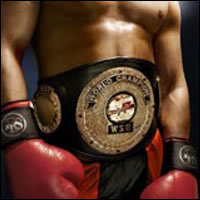 for sound quality in car audio competitions for two years running. I sat inside, had a listen and wished I could nail a few UK home hifi reviewers to the seat and then play them a ditty. If only to see the look on their faces when, instead of breast-bone excursion, they get audiophile sounds.
for sound quality in car audio competitions for two years running. I sat inside, had a listen and wished I could nail a few UK home hifi reviewers to the seat and then play them a ditty. If only to see the look on their faces when, instead of breast-bone excursion, they get audiophile sounds.
DLS care desperately about their engineering and more than pretty much any other maker, are very proud of their competition results. Cars roll up to a show and experts listen to them for placement of sounds in the stereo field, accuracy of tonality and speed of transient response. They use special discs of odd music and some bloke speaking: ‘Now I am in the left hand speaker channel..’ and they also judge the craftsmanship with which the system has been assembled. This most-winning system I listened to (In an Audi A3) had its tweeters mounted on solid billets of Aluminium so as to couple them directly to the steel of the front pillars in order to prevent flexing of the mount. This is like using really rigid speaker stands indoors and is all about stopping that diaphragm on the tweeter from shaking the whole baffle (If a tweeter dome weighed as little as only one ten thousandth of a kilo and only had to change direction at up to 20kHz, it’d be subject to ten thousand gravities of acceleration and so offer a one kilogram shove against the mounting – and that’s enough to smear the sound.) These tweeters sounded literally incredible. So did the whole system. So, if winning at sound off contests Sound Quality scene is your urge, you could do far worse.
First Place Wins in 2006. Thailand, ISQC & IASCA – Ultimate Pro: USA – Semi-Pro Street, Pro Street and Rookie: Slovenia, EMMA – Expert Unlimited, Amateur 600 and Best Installation: Sweden – Expert Sound Only: Russia – Pro 600, Multimedia Pro and Best of Dolby Multimedia.
DLS’ equipment comes in three basic grades of engineering, with levels within each. Nearly all they make is imported into the UK by AVHQ, only avoiding those few products that face a market awash – which is some of their entry level equipment. The lines are Classic, Reference and Ultimate, as a Good, Better, Best type of arrangement. We’ll start off with the posh speaker stuff&$$.
Noblesse Oblige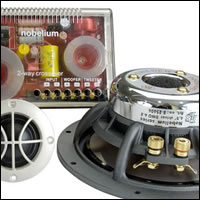
At the top of the top line are the Nobelium monikered speakers. Made with Aluminium cones, cast baskets, real rubber surrounds and coils made with flat wound wire, they are a bit special. Flat wound means oblong cross-section wire, not circular, so there are no little gaps in the coil of wire, it’s all metal and it all grips and shoves the harder for it when in that magnetic gap. The magnets are made with the Rare Earth element called Neodymium, which makes them very powerful for all their diminutive size and the terminals are expensive screw down types with gold plate on them for better connection. The 28mm textile dome tweeters have a metal rear chamber and are very special. Their passives are made with high end components. Prices go £549, £599 and £649 for two-way five inch UN5.2, six inch UN6.2 and UN8.2 eight-inch woofer based systems, with UN1 tweeters alone costing £175. Whew! The subwoofers that go with them are posh and pricey too. With 180 Ounce magnets and dual 4 Ohm voice coils, they can use either 800w or 600w RMS, with kilowatt peaks easily eaten. They price at £399, £449 and £575 for a NOB10, NOB12 or a huge NOB15. These are speakers for seriously discerning people.
Ultimate Iridium
This product is very like the Nobelium but is a bit more traditional. At least as well made, with the same hard parts, the main difference is that the cones are honest paper pulp for warmth of sound rather than Aluminium for snap and taut response. Perhaps sweeter, they are available in systems up to three way with eight inch woofers and there is a delicious nearfield midrange driver three inches across that is a lovely thing. Looking a lot like the sort of drivers they use in recording studios’ near field monitors, they go from six inch in two and three way (UI6.2i & 6.3i at £525 and £699 respectively) to eight inch in two and three way for £550 – UI8.2i or £725 – UI8.3i. The UIMID domes alone cost £159, the UITWi tweeters a tiny bit less than Nobeliums at ‘only’ £149. The woofers are again built just like the Nobeliums but have paper pulp cones. They will cost you £289 for an IR10, £368 for an IR12 and £471 for an IR15. Sealed or vented enclosures, Iridium speakers will appeal to lovers of multi-way carefully balanced active systems, although the passives with the components are top notch, with ribbon coils and polypropylene capacitors. Classy, with more old school sound and also claims to be the top end of the line, as er, does the Nobelium. At this price, you should go to a specialist and hear a set before you spend, though.
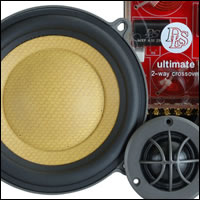 Ultimate UR
Ultimate UR
The Ultimate UR series has tri-layer honeycomb cones on its midwoofers and also has the sexy textile dome tweeters. The mids use a cast chassis but the tweeters have rigid polymer frames and the mid dome in the system is a different model to the NOB and IR series. Available as a five or six inch based system in either two or three way with pukka passive crossovers, they are the UR5i and UR6i for £425 or £449 and the UR35i & 36i for £559 or £579 the UR2.5 mid domes are £120 and the UR1 tweeters are £111. Although just discontinued, there are limited stocks of the UR woofers in 10, 12 and 15 inch sizes, for £265, £344 and £453.
Ultimate UP
These are a good example of filtered-down technology. Much cheaper than most of the rest, they have simple pressed chassis and less technology involved. The tweeters have no back chambers for example. However, for all their lightness, they are well above the performance of most other products of their type. They again come in two and three-way systems based around either a five or six inch midbass and are a good bit cheaper, with £276 being the price for either size in two way – UP5UP6 – and £372 being the tag on the UP35 and UP36 three way sets. The subwoofers in the Ultimate range here are the SPL or loudness (Sound Pressure Level) models. They are meant for heavy duty competition use although not as mad weapons-grade as some out there. They are a special order item at AVHQ and will set you back £717 for a mighty eighteen inch SP18S, or £541, £460 or £331 as you go from 15 down to 10. All 500w rms but rated to two kilowatts for SPL contest use. Monster three inch, four layer, two Ohm voice coils in clusters – three on the 18, four on the fifteen and two each on the ten and twelve. Light, sensitive cones make for hellish levels.
Cunning Basserators
The BB26, all £259’s worth of it, is a small but perfectly formed item. It has but two small Reference 6.5inch woofers in its baffle, yet they can make the same amount of bass as a decent ten inch woofer. This is because the surface area and motor shove on the back of each woofer all adds up to the same amount of air being pushed around as a decent ten.
I heard a Porsche with two of the Reference range RW6 drivers and thought it was a ten incher at least. Real, melodic, grippy bass with weight. The RW6 kit comprises two of the 6.5inch RW6 woofers and a DLS aeroport pipe that is just right to tune a 0.6cu.Ft. box. You also get some instructions (they include various designs) as to how to build a box correctly for your £179. It opens up all sorts of skinny locations to get bass involved and even allows for the holy grail of the audiophile in-car. Front of the car bass. It doesn’t always have to go in the boot with these. MB Quart had some many years ago, but these are rare as hen’s teeth and just as special.
Muscle
Ultimate amplifiers are available in seven models and include one with a ‘tube’ or sort of a light bulb in it. These are said to make a sweet and natural sound and are beloved of home audio nutters. Car amps with valves as they are also called, are as rare as snake’s pyjamas, let alone avian dentition. Class AB with pair-matched transistors, they are well engineered, with beefy power supplies and will drop full Wellington even when the load gets tough (the impedance drops). Terminals are all gold plated brass and of course, there are protection circuits onboard. They are numbered A2 to A7 as well as having names. 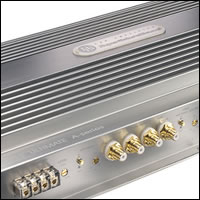 Simply descriptive. Hence, the A2 is called the Mid Stereo and is a 2x85w RMS job with a 50Hz to 125Hz settable lowpass filter on it for £439. The A3 is called The Twin Mono and is a true dual mono block with two power supplies inside. This gives it serious spoke and grip. It’ll cost you £625. High and low pass filters, a phase flip switch and two places to stick fat power wires up it complete the package. A4 is The Big Four (£799) and offers a double-up of the A2’s innards. It also adds a 20Hz to 200Hz high pass filter to the same one as is found on the A2. A5 is a rare three channel design, except DLS make lots of three channel designs, one in each range. This one has 2×85+1x500w@2ohms RMS and is priced at £609. A6 is The Mono Amp and has a simple single channel of clean bass power with 1200 watts RMS at an Ohm. Ooof. It has a built in fan but also features an output to drive an external fan for shroud-installation use. (When you put it under a Perspex layer for instance) This amp is only rated for bass frequencies 20Hz to 125Hz. It’s priced at £525. A7 is The Big Five and has four 60w RMS channels, one 440w RMS bass channel and lots of crossovers on it. A built in fan controller and also includes a remote subwoofer gain knob for your £775. AVHQ don’t list the TA2 The Tube Amp in their list but if you want to know, I’m certain you’ll get individual attention like any one of their customers. Go on, nag ’em!
Simply descriptive. Hence, the A2 is called the Mid Stereo and is a 2x85w RMS job with a 50Hz to 125Hz settable lowpass filter on it for £439. The A3 is called The Twin Mono and is a true dual mono block with two power supplies inside. This gives it serious spoke and grip. It’ll cost you £625. High and low pass filters, a phase flip switch and two places to stick fat power wires up it complete the package. A4 is The Big Four (£799) and offers a double-up of the A2’s innards. It also adds a 20Hz to 200Hz high pass filter to the same one as is found on the A2. A5 is a rare three channel design, except DLS make lots of three channel designs, one in each range. This one has 2×85+1x500w@2ohms RMS and is priced at £609. A6 is The Mono Amp and has a simple single channel of clean bass power with 1200 watts RMS at an Ohm. Ooof. It has a built in fan but also features an output to drive an external fan for shroud-installation use. (When you put it under a Perspex layer for instance) This amp is only rated for bass frequencies 20Hz to 125Hz. It’s priced at £525. A7 is The Big Five and has four 60w RMS channels, one 440w RMS bass channel and lots of crossovers on it. A built in fan controller and also includes a remote subwoofer gain knob for your £775. AVHQ don’t list the TA2 The Tube Amp in their list but if you want to know, I’m certain you’ll get individual attention like any one of their customers. Go on, nag ’em!
Reference Range
The Reference speakers are divided up into R Series, MS Series and RS in the AVHQ line up. The R Series has carbon fibre reinforced paper pulp cones and they go from 4inch to 6.5inch in two-way and there is a 6.5inch/2.5inch mid/tweeter three-way set as well. They are priced from £137 to £279. Their woofers to match are priced between £123 and £157 for two grades of power handling. Either 180w or 200w RMS for the W610 and W612, or 200w and 250w RMS for the W710 and W712. There is even a fifteen called the RW15 priced at £279. The Magnesium cone jobs are however, available and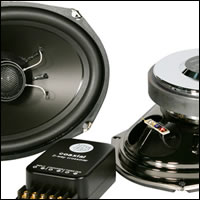 priced at £174 for MW10 or £221 for a 12 inch MW12. They are the tougher of the four models available and rated for 400w RMS. With dual spiders they can make hard big-assed bass in even small boxes. These are tough cookies.
priced at £174 for MW10 or £221 for a 12 inch MW12. They are the tougher of the four models available and rated for 400w RMS. With dual spiders they can make hard big-assed bass in even small boxes. These are tough cookies.
Some of my all time favourite items of theirs are in this range. The R964 and R1070 ovals are a bit potent to say the least and priced at £164 and £201 respectively, I should hope so. The R1070 in particular may be the beefiest oval in existence anywhere. In fact the 41 out of 40 points I awarded it in Fast Car gets made mention of in the very catalogue, which is nice. The Reference Slimlines or RS are available as 5inch or 6inch two-way component sets and although not too slim next to skinny Far Eastern product are far slimmer than DLS’ usual meaty magnets. They are £157 or £139 pounds a set.
The MS5A and MS6A are priced £179 and £209 for the 5.25 and 6.5 two-way component systems and feature metal cones with great midband spank. Especially good for rock nutters, these are affordable firepower in DLS terms.
Reference amplifiers are easier to install as they feature high level or speaker wire inputs as well as the more normal RCAs but are good enough to be used in and win at competitions. They are priced from £299 to £599 and include RA10, 20, 25, 30, 40 and 50. RA10 is a single channel 300 watter, the 20 is a 2x130w design, the 25 2x75w. RA30 is one of those three channellers and has 2×70+1x100w RMS, with the RA40 offering 4x75w RMS. RA50 has the same as two RA25 plus a 1x265w bass channel.
Classic Hardware
There are a few sets of kit in the Classic range. Here are the ones that AVHQ specialise in: The Classic B series B5A and B6A sets are 5 and 6inch two way components reasonably priced at £95 and £90. They feature what DLS call EFR or Extended Frequency Response. This means they can reach higher up than normal midband drivers, so they make less work for the tweeters to do. Less of the deeper middly tones make the HF (high frequency) units sound better and they do well in tests of like priced kit, we gather. We’ll check that out in time on the reviews section ourselves.
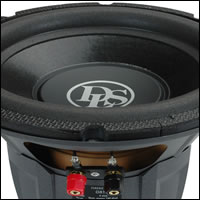 Classic coaxials number seven models, with 4, 5, 6inch and a mighty eight inch model and three ovals; a 5×7 and a three-way and a two-way 6×9. They go from £108 to £149 a set.
Classic coaxials number seven models, with 4, 5, 6inch and a mighty eight inch model and three ovals; a 5×7 and a three-way and a two-way 6×9. They go from £108 to £149 a set.
Basic series kit is the cheapest way to buy into the brand and will set you back between £66 for a set of DLS 224 four inch coaxes to £140 for the DLS 1072 7×10 oval.
As for Classic woofers, the Open Air models are actually meant for simply hanging in your parcel shelf with no box. Almost unheard of these days, I understand they work well and do not unload under pressure. They are called OA8, 10 and 12 and cost £89, £126 and £139 apiece. They have dual magnet systems and dual bottom suspension spiders for better linearity. The W308B, 310B and 312B are equipped with non-pressed carbon fibre reinforced paper pulp cones and Butyl rubber top roll suspensions, so they are not pap. They are, however easily affordable next to some of the exotica in the line at £76, £92 and £99, still not dirt cheap, but DLS don’t make any dirt products. They are not too fussy about what sort of box they get put in, too.
Classic amplifiers number eight in total and they are significantly less expensive than the top end products. There are three monoblocks, the £449 CAD11 digital with 1x400w RMS at 4 Ohms, but 1,050w at an Ohm. With big brother CAD15 (£625) that makes 1,600w under the same 1 Ohm load. The baby mono is the £229 CA12 that’ll drop 500w. The two 2 channel models are the £169 2x50w RMS CA22 and the £235 2x135w RMS CA23. With a 2x65w RMS section and a 1x170w bass section, the £268 CA31 is a single footprint full system solution. The incredibly rare CAT31 is a three channel design, like the CA31 but actually equipped to run off 24Volt electrics as in T is for Truck. It does 2x90w +1x170w. All other brands need voltage conversion that wastes power. The four channel CA41 costs £269 and has 4x 70w RMS and features a 0-18dB bass boost usable between 25Hz and 80Hz. Lastly king of the ranges single-footprint amps is the five channel CA51 for £335 with 4x50w and 1x170w RMS.
- Incredible product reputation through competition wins
- Speakers from merely affordable all the way to high end
- Top materials and components used – ribbon wire inductors etc.
- Variety of product within each level of excellence
- Amplifiers with huge power and control in all ranges
- Horribly rare things like 3channel and 24V DC amps
- Big players in SQ but with serious SPL product, too.
AVHQ Customer support telephone number 01923 777 994
www.dls.se
